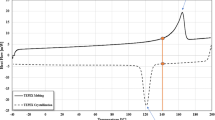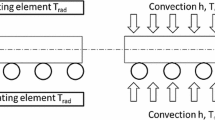Abstract
The residual stresses accumulated in the forming process have great effects on the product quality of the glass bulb. Based on the characteristics analysis of glass bulb forming, a mathematical model has been established for calculating residual stresses of glass pressing process. The material is assumed as thermorheologically simple thermoviscoelastic material, and the flow-induced stress is neglected. The consequences of equilibrium and compatibility equations are discussed in detail, and the boundary conditions are specified for various stages of the forming process. The numerical solution is based on the theory of thin layers, combined with finite difference method in the time and layer difference in the thickness direction. The presented model and solution method could easily be extended to general pressing process of glass, and applied to problems relative to glass pressing, providing extensive reference values.
Similar content being viewed by others
References
Leaderman H. Rheology. Vol. 2. New York: Academic Press, 1958. 1–61
Schwarzl F, Staverman A J. Time-temperature dependence of linear viscoelastic behavior. Appl Phys, 1952, 23(8): 838–843
Gurtin M E, Sternberg G E. Further study of thermal stresses in viscoelastic materials with temperature-dependent properties. Second-order Effects in Elasticity, Plasticity and Fluid Dynamics, International Symposium, Haifa, Israel, 1962, 51–76
Lee E H, Rogers T G. Solution of stress analysis problems for linear viscoelastic materials based on measured deformation functions. J Appl Mech-T ASME, 1963, 30: 127–133
Lee E H, Rogers T G. On the generation of residual stresses in thermoviscoelastic bodies. J Appl Mech-T ASME, 1965, 32: 874–880
Narayanaswamy O S, Gardon R. Calculation of residual stresses in glass. J American Ceram Soc, 1969, 52(10): 554–558
Aggarwala B D, Saibel E. Tempering stress in circular plates and cylinders. J Math Phys Sci, 1968, 2: 321–332
Dumora D, Saisse H, Knosp B, et al. Thermal tempering study of glass insulators by means of a finite element modelization. Indian Ceram Soc, 1986, 3: 151–160
Chabrand P, Licht C, Maisonneuve O, Raous M. Residual thermal tempering stresses. Comput Struct, 1989, 31(6): 1003–1011
Mauch F, Jackle J. Thermoviscoelastic theory of freezing of stress and strain in a symmetrically cooled infinite glass plate. J Non-cryst Solids, 1994, 170(1): 73–86
Daudeville L, Carre H. Thermal tempering simulation of glass plates: Inner and edge residual stresses. J Therm Stresses, 1998, 21(6): 667–689
Daudeville L, Bernard F, Gy R. Residual stresses near holes in tempered glass plates. Mater Sci Forum, 2002, 404–407: 43–48
Bushko W C, Stokes V K. Solidifcation of thermoviscoelastic melts. Part I: Formulation of model problem. Polym Eng Sci, 1995, 35(4): 351–364
Lee Y B, Kwon T H, Yoon K. Numerical prediction of residual stresses and birefringence in injection/compression molded center-gated disk. Part I: Basic modeling and results for injection molding. Polym Eng Sci, 2002, 42(11): 2246–2272
Lee Y B, Kwon T H, Yoon K. Numerical prediction of residual stresses and birefringence in injection/compression molded center-gated disk. Part II: Effects of processing conditions. Polym Eng Sci, 2002, 42(11): 2273–2292
Kamal M R, Lai-Fook R L, Hernandez-Aguilar J R. Residual thermal stresses in injection moldings of thermoplastics: A theoretical experimental study. Polym Eng Sci, 2002, 42(5): 1098–1114
Zhou H M, Yan B, Li D Q. Three-dimensional numerical simulation of the pressing process in TV panel production. Simulation, 2006, 82(3): 193–203
Zhou H M, Cui S B, Li D Q. Numerical simulation of temperature history during the picture tube panel forming process. Eng Computation, accepted
Aben H, Ainola L, Anton J. Integrated photoelasticity for nondestructive residual stress measurement in glass. Opt Laser Eng, 2000, 33(1): 49–64
Gerasimov S I, Bachurina N S, Emelyanova N N. Application of photoelasticity for analysis of residual stresses in CDs. Proc SPIE Int Soc Opt Eng, 2002, 4900(1): 606–610
Author information
Authors and Affiliations
Corresponding author
Additional information
Supported by the National Natural Science Foundation of China (Grant No. 50205011), and the Program for New Century Excellent Talents in University (Grant No. NCET-04-0718)
Rights and permissions
About this article
Cite this article
Zhou, H., Xi, G. & Li, D. Modeling and simulation of residual stresses during glass bulb pressing process. SCI CHINA SER E 50, 103–117 (2007). https://doi.org/10.1007/s11431-007-2033-6
Received:
Accepted:
Issue Date:
DOI: https://doi.org/10.1007/s11431-007-2033-6




